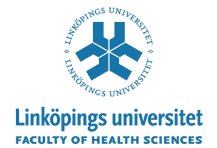 |
Visa svensk kursplan |
|
COURSE CATEGORY Single subject course MAIN FIELD OF STUDY SUBJECT AREA |
COURSE CODE | 8FA025 |
Learning Outcomes
By the end of the course the students will be able to:
-Discuss specific capabilities of cancer cells and how they are related to genetic alterations and normal cell biology and development
-Integrate knowledge in cancer biology in order to discuss different human malignancies in relation to age, sex, hormonal influence, environmental factors, as well as molecular alterations
-Design experiment in order to analyse how alterations in cell signalling may interfere with the cellular response to damage
-Integrate the results of a series of experiments and make conclusions by applying knowledge in cancer biology
-Apply knowledge in cancer biology in order to discuss new hypotheses in the field of cancer research, such as cancer stem cells
-Identify the state of the art of a chosen topic by a search and summarise the findings in an oral presentation and a written abstract
-Control of the cell cycle and cancer
-Caretaker genes
-Apoptosis and cancer
-Immortalization
-Tumour progression
-Mechanisms of invasion and metastasis
-Angiogenesis and cancer
-Tumour immunology
-Hormones and cancer
-Cancer by the site: different spectra of malignancies in relation to age, sex, hormones, and molecular biology
Laboratory Work
Two main laboratory works are included in the course. Each of them consists of different parts. The design is in part decided by the tutorial group. The results of the first laboratory works will be discussed in the tutorial group and presented at a seminar. The second laboratory works will be summarised in a written report on an individual basis.
Deeper studies
During the course each participant should choose one topic for a study in-depth. The studies will be presented at a final seminar.
Seminars
The results of the first laboratory works and the results of deeper studies will be presented and discussed at seminars. The participation is compulsory.
Students who have failed the course or part of the course twice are entitled to request another examiner for the following examination occasion.
Extent of re-examination:
The extent of a re-examination shall be similar to the regular examination.
Entries for examinations:
Rules for entries for examination are given in the course plan. In addition the "Regulations regarding examinations and examiners" laid down by decision of Linköpings University (Dnr LiU 1109/00-40) apply.
Applicants with a degree from a non-Swedish university must enclose an official examination certificate of at least three years of full-time studies in subjects with relevance for Life Science, such as biology, chemistry, medicine or the like.
Documented knowledge of English equivalent to ”Engelska B”; i.e. English as native language or an internationally recognized test, e.g. TOEFL (miminum scores: Paperbased 550 + TWE-score 4.0, computerbased 213 and internetbased 79), IELTS, academic (minimum score: Overall band 6.0 and no band under 5.0), or equivalent.
Planning and implementation of the course shall be carried out from the wording in this course plan. The evaluation of the course should therefore consider the question how well the course agrees with the course plan. The evaluation will be written on a scheduled time point at the end of the course.
Electronic evaluation of the course in accordance with Linköping University´s regulations will in addition be done (Dnr LiU 780/06-04).
Certificate
At the student´s request, a course certificate may be issued by the director of studies for courses or, according to delegation, by the head of the department/director of programme studies.
Additional Information
The course is given in such a way that both men´s and women´s experiences and knowledge are made visible and developed.
If the course is withdrawn, or is subject to major changes, examinations according to this course plan are normally offered on a total of three occasions within one year, one of them in close connection with the first examination.
|
||||||||||||||||||||||||||||||||||||||||||||||||||||||||||||||||||||||||||||||